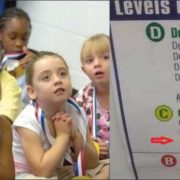While visiting a public park out-of-state recently, we met a young boy who shares many interests with my 8-year-old son and is also homeschooled. They hit it off immediately and we met up with Matt, along with his mom and younger brother, several times. Schooling can bring out the worst behaviors.
We learned that life is tough for this family. Matt’s father isn’t around, and his mother struggles as a single mom supporting two young children on her own. She pulled Matt out of public school a couple of years ago feeling that it wasn’t working for him. He was labeled as hyperactive, a troublemaker, a slow reader, a kid with a temper.
As I interacted with this engaging, polite, energetic boy, it became obvious to me how mass schooling would be a terrible fit for him – a square peg in a round hole. Mass schooling was designed to crush a child’s natural exuberance and make him conform to a static set of norms and expectations.
Being Labeled a Deviant
For kids like Matt, schooling can bring out the worst behaviors. Like a trapped tiger – angry and afraid – they rebel.
Unable to conform, they get a label: troubled, slow-learner, poor, at-risk.
Unable to conform properly to mass schooling’s mores, they get a label: troubled, slow-learner, poor, at-risk. They will carry these scarlet letters with them throughout their 15,000 hours of mandatory mass schooling, emerging not with real skills and limitless opportunity, but further entrenched in their born disadvantage. A tiny few may succeed at overcoming these labels – a dangling carrot that sustains the opportunity myth of mass schooling – but the vast majority do not.
Monique Morris writes in her book, Pushout: The Criminalization of Black Girls in Schools: “Literature on the structure of dominance and the socially reproductive function of school tells us that schools may reinforce and reproduce social hierarchies that undermine the development of people who occupy lower societal status.”
In reference to the black girls she writes about in her book, Morris concludes that “these socially reproductive structures constitute educational experiences that guide them to, rather than direct them away from, destitution and escalating conflict with the criminal justice system.”[1]
That is why I was heartbroken to hear that Matt is going back to school in the fall.
What Do You Do With No Real Alternatives?
I understand why his mother feels she has no other choice but to send him there. She’s struggling to support her family on her own, to build a better life for her kids. It’s hard to be a single mom and to homeschool. In fact, a new homeschooling report issued last week by Boston’s Pioneer Institute for Public Policy Research shows that 90 percent of homeschoolers live in two-parent families, and they are three times more likely to have one be a stay-at-home parent. Homeschooling as a single mom is beyond hard.
Homeschooling as a single mom is beyond hard.
But it doesn’t have to be. If Matt’s mom could enroll him in a self-directed learning center, like those scattered across the country, she could support her family and continue to homeschool Matt with a complementary learning environment that encourages freedom and autonomy and pursuit of his passions and gifts. These learning centers, where tuition is typically only a fraction of a standard private school, often rely on donations to offer sliding scale fees or scholarships.
Of course, if Matt’s mom had a voucher that could help too, not only in defraying some education costs but also in encouraging the innovation and entrepreneurship necessary to launch more of these self-directed learning centers – and other school alternatives – across the country.
Imagine if some of the over $600 billion that American taxpayers are charged each year to pay for U.S. public schools were re-allocated to create alternatives to the mass schooling monopoly. Imagine what that might do to help families like Matt’s.
Generating a Resistance to Learning
I can see the reel playing before me of Matt’s remaining years in school: the endless discipline, the daily detentions, the force-fed academics, the testing that masquerades as learning, the sadness and despair that will only be amplified now that Matt has had a taste of education freedom and autonomy. He knows how learning can be, should be, but for most children is not.
As Schooling the World documentary filmmaker, Carol Black, writes in her powerful essay:
Children’s resistance takes many forms; inattention, irritability, disruption, withdrawal, restlessness, forgetting; in fact, all of the ‘symptoms’ of ADHD are the behaviors of a child who is actively or passively resisting adult control. Once you start to generate this resistance to learning, if you don’t back away quickly, it can solidify into something very disabling.”
I hope I’m wrong. I hope school will be ok for Matt this time around. But I am not optimistic. And I am angry: angry that mass schooling is the only other option for Matt, angry because this was how the system was designed to be. Remember: Horace Mann, the proclaimed “father of American public education” who created the nation’s first compulsory schooling law in Massachusetts in 1852, homeschooled his own three children with no intention of sending them to the common schools he mandated for others.
The Pioneer Institute homeschooling report says of Mann:
This hypocrisy of maintaining parental choice for himself while advocating a system of public education for others seems eerily similar to the mindset that is so common today: Many people of means who can choose to live in districts with better schools or opt for private schools resist giving educational choices to those less fortunate.”
Matt is an important reminder for me of why I advocate so strongly for education choice and parental empowerment. He should be a reminder for all of us that mass schooling was created as a system of social control for those without privilege. If we truly care about equity we should care about choice.
[1] Morris, Monique. Pushout: The Criminalization of Black Girls in Schools. New York: The New Press, 2016, p. 188.
Reprinted from Whole Family Learning.
This article was originally published on FEE.org. Read the original article.











